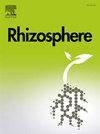Identification of Phytophthora nicotianae tolerant citrus hybrids using subordinate function analysis of disease and morpho-physio-biochemical responses
IF 3.4
3区 生物学
Q1 PLANT SCIENCES
引用次数: 0
Abstract
Phytophthora nicotianae is a devastating fungus, which causes significant losses to citrus. To find new Phytophthora tolerant citrus rootstock hybrids, 13 Rangpur lime (RL; susceptible parent) × sour orange (SO; tolerant parent) hybrids were screened against P. nicotianae using artificial soil inoculation method. Their response was judged on the basis of feeder root rot (FRR) ratings and the alterations of morphology (shoot length, shoot diameter, leaf number and root weight), physiology [net photosynthesis rate (Pn), transpiration rate (E), stomatal conductance (gs)] and activity of defence enzymes [Leaf and root activity of peroxidase (POX), lipoxygenase (LOX), and phenyl alanine ammonia lyase (PAL)] under Phytophthora infection. In FRR ratings (1–5), the donor parent, SO and six hybrids scored rating of one, delineating to the tolerant reaction. From rest, four, two and one hybrids were rated as moderately tolerant (MT), moderately susceptible (MS) and susceptible (S), respectively. Phytophthora infection adversely impacted the morphological and physiological parameters in most of the hybrids. A significant (P < 0.05 or 0.01) negative correlation of feeder root rot ratings (FRRR) with morphological (r = −0.53 for shoot length to r = −0.87 for shoot diameter) and physiological traits (r = −0.76 for leaf chlorophyll content to r = −0.95 for transpiration rate) verified this adverse impact. The relative reduction in these parameters was maximum for S or MS-individuals, while the T-individuals were least affected. The transpiration rate among physiological parameters witnessed significant (P < 0.01) reductions only for S or MS category hybrids, indicating its importance in screening programs. Among the enzymes, the leaf POX activity showed moderate negative relationship with FRR score, reflecting its role in host defence. The six tolerant hybrids harboured high leaf POX activity (≥1000 ΔA min−1 g−1 fresh weight), while it was lower in S or MS category hybrids. To find overall response of the hybrids to pathogen infection, principal component analysis (PCA) and subordinate function analysis were performed on all the parameters, and comprehensive value (D-value) was calculated. SO attained the D value of 0.716 while RL scored 0.060. Four of the six tolerant hybrids shared D value in the range of 0.700–0.905. The four tolerant hybrids identified through this comprehensive analysis should prove useful to the citrus industry provided that the tolerance to other biotic and abiotic stresses is evaluated.
利用从属功能分析和形态生理生化反应鉴定柑橘耐烟草疫霉杂交种
烟草疫霉(Phytophthora nicotianae)是一种破坏性真菌,对柑橘造成重大损失。寻找耐疫霉柑桔砧木杂交种13个;敏感亲本)×酸橙(SO;采用人工土壤接种的方法,筛选了耐受性强的亲本杂交品种。根据食用菌根腐病(FRR)等级、形态(茎长、茎粗、叶数和根重)、生理(净光合速率(Pn)、蒸腾速率(E)、气孔导度(gs))和防御酶(叶片和根系过氧化物酶(POX)、脂氧合酶(LOX)和苯丙氨酸解氨酶(PAL)活性)在疫霉侵染下的变化来判断它们的反应。在FRR评分(1-5)中,供体亲本、SO和6个杂交种得分为1分,描述了耐受性反应。其余4个、2个和1个杂种分别被评为中度耐受性(MT)、中度敏感(MS)和敏感(S)。疫霉侵染对大部分杂种的形态和生理参数产生不利影响。P <;食料根腐病等级(FRRR)与形态性状(茎长r = - 0.53 ~茎直径r = - 0.87)和生理性状(叶片叶绿素含量r = - 0.76 ~蒸腾速率r = - 0.95)呈负相关(0.05或0.01),证实了这种不利影响。这些参数的相对降低在S和ms个体中最大,而t个体受影响最小。生理参数中蒸腾速率显著(P <;0.01),仅在S或MS类杂交种中降低,表明其在筛选程序中的重要性。其中,叶片痘酶活性与FRR评分呈中等负相关,反映了其在宿主防御中的作用。6个耐受性杂交种的叶痘活性较高(≥1000 ΔA min−1 g−1鲜重),而S类和MS类杂交种的叶痘活性较低。通过主成分分析(PCA)和隶属函数分析(subfunction analysis)对各参数进行分析,计算综合值(D-value),得出杂种对病原菌侵染的总体反应。SO的D值为0.716,RL为0.060。6个耐受性杂交种中有4个的D值在0.700 ~ 0.905之间。如果对其他生物和非生物胁迫的耐受性进行评估,通过这种综合分析鉴定出的四种耐受性杂交种将对柑橘产业有用。
本文章由计算机程序翻译,如有差异,请以英文原文为准。
求助全文
约1分钟内获得全文
求助全文
来源期刊

Rhizosphere
Agricultural and Biological Sciences-Agronomy and Crop Science
CiteScore
5.70
自引率
8.10%
发文量
155
审稿时长
29 days
期刊介绍:
Rhizosphere aims to advance the frontier of our understanding of plant-soil interactions. Rhizosphere is a multidisciplinary journal that publishes research on the interactions between plant roots, soil organisms, nutrients, and water. Except carbon fixation by photosynthesis, plants obtain all other elements primarily from soil through roots.
We are beginning to understand how communications at the rhizosphere, with soil organisms and other plant species, affect root exudates and nutrient uptake. This rapidly evolving subject utilizes molecular biology and genomic tools, food web or community structure manipulations, high performance liquid chromatography, isotopic analysis, diverse spectroscopic analytics, tomography and other microscopy, complex statistical and modeling tools.
 求助内容:
求助内容: 应助结果提醒方式:
应助结果提醒方式:


